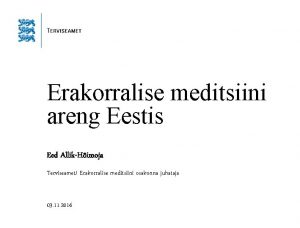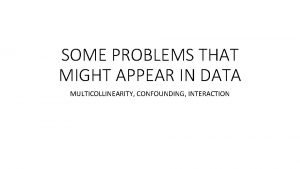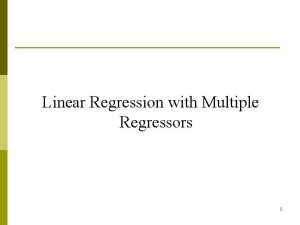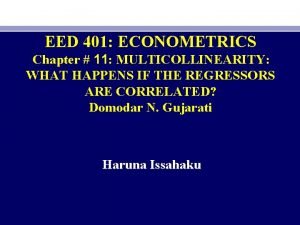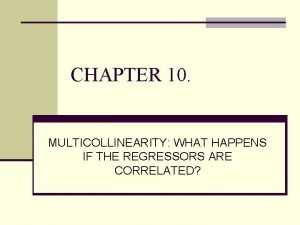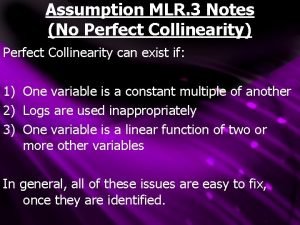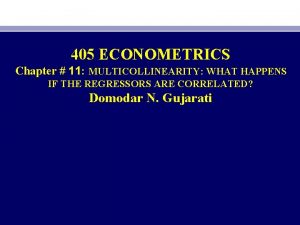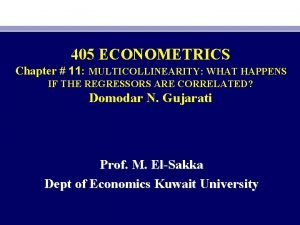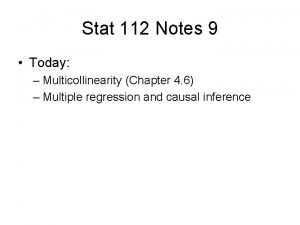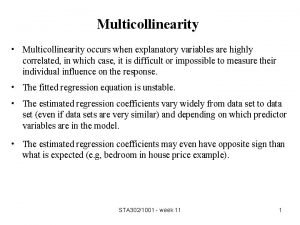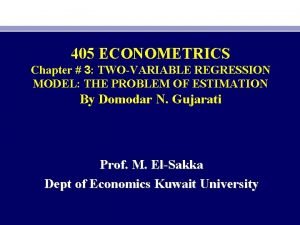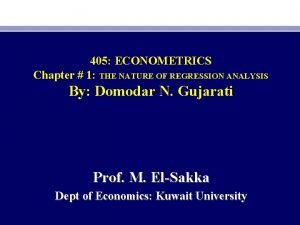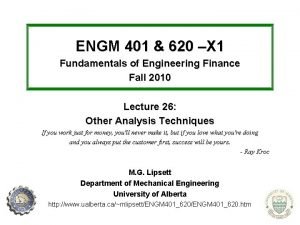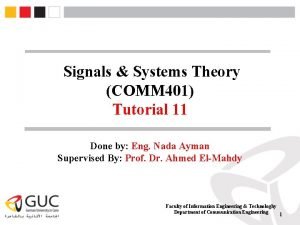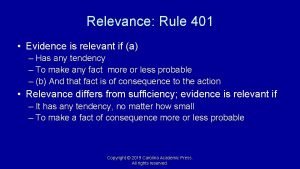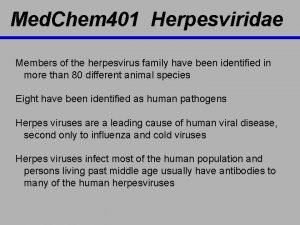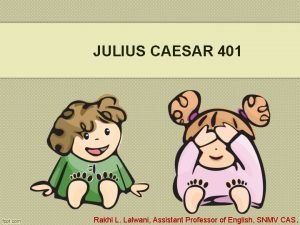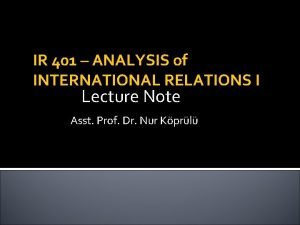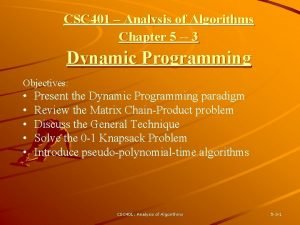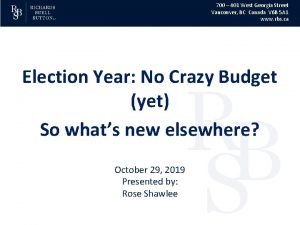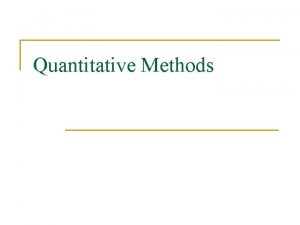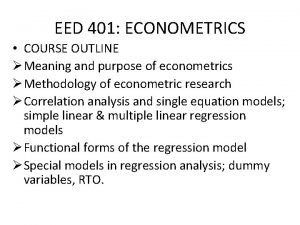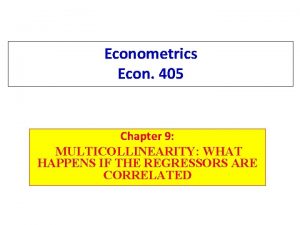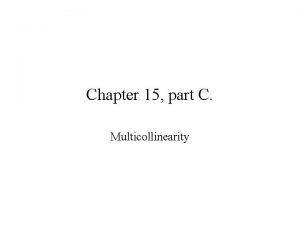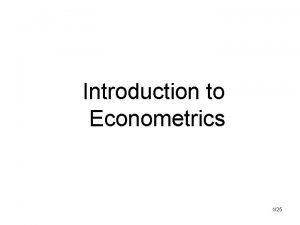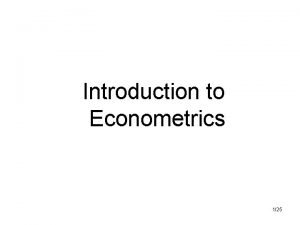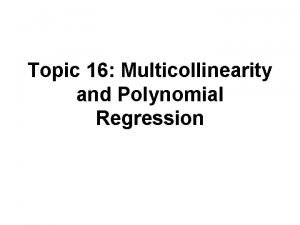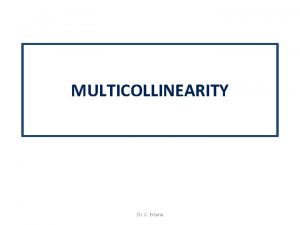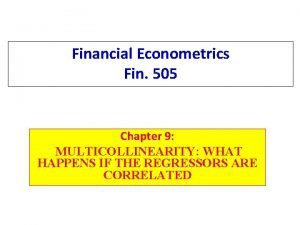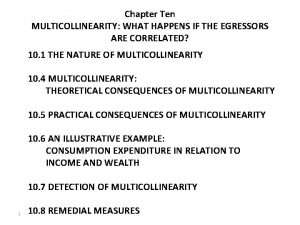EED 401 ECONOMETRICS Chapter 11 MULTICOLLINEARITY WHAT HAPPENS









































- Slides: 41

EED 401: ECONOMETRICS Chapter # 11: MULTICOLLINEARITY: WHAT HAPPENS IF THE REGRESSORS ARE CORRELATED? Domodar N. Gujarati Haruna Issahaku

• In this chapter we take a critical look at this assumption by seeking answers to the following questions: • 1. What is the nature of multicollinearity? • 2. Is multicollinearity really a problem? • 3. What are its practical consequences? • 4. How does one detect it? • 5. What remedial measures can be taken to alleviate the problem of multicollinearity?

THE NATURE OF MULTICOLLINEARITY • Multicollinearity originally it meant the existence of a “perfect, ” or exact, linear relationship among some or all explanatory variables of a regression model. • For the k-variable regression involving explanatory variable X 1, X 2, . . . , Xk • (where X 1 = 1 for all observations to allow for the intercept term), an exact linear relationship is said to exist if the following condition is satisfied:

• λ 1 X 1 + λ 2 X 2 +· · ·+λk. Xk = 0 (10. 1. 1) • where λ 1, λ 2, . . . , λk are constants such that not all of them are zero simultaneously. • Today, however, the term multicollinearity is used to include the case where the X variables are intercorrelated but not perfectly so, as follows: • λ 1 X 1 + λ 2 X 2 +· · ·+λ 2 Xk + vi = 0 (10. 1. 2) • where vi is a stochastic error term.

• To see the difference between perfect and less than perfect multicollinearity, assume, for example, that λ 2 ≠ 0. Then, (10. 1. 1) can be written as: • which shows how X 2 is exactly linearly related to other variables. • In this situation, the coefficient of correlation between the variable X 2 and the linear combination on the right side of (10. 1. 3) is bound to be unity. • Similarly, if λ 2 ≠ 0, Eq. (10. 1. 2) can be written as: • which shows that X 2 is not an exact linear combination of other X’s because it is also determined by the stochastic error term vi.

• • As a numerical example, consider the following hypothetical data: X 2 X 3 X*3 10 50 52 15 75 75 18 90 97 24 120 129 30 152

It is apparent that X 3 i = 5 X 2 i. Therefore, there is perfect collinearity between X 2 and X 3 since the coefficient of correlation r 23 is unity. The variable X*3 was created from X 3 by simply adding to it the following numbers, which were taken from a table of random numbers: 2, 0, 7, 9, 2. Now there is no longer perfect collinearity between X 2 and X*3. (X 3 i = 5 X 2 i + vi ) However, the two variables are highly correlated because calculations will show that the coefficient of correlation between them is 0. 9959.

• The preceding algebraic approach to multicollinearity can be portrayed in Figure 10. 1). • In this figure the circles Y, X 2, and X 3 represent, respectively, the variations in Y (the dependent variable) and X 2 and X 3 (the explanatory variables). • The degree of collinearity can be measured by the extent of the overlap (shaded area) of the X 2 and X 3 circles. • In the extreme, if X 2 and X 3 were to overlap completely (or if X 2 were completely inside X 3, or vice versa), collinearity would be perfect.


Why does the classical linear regression model assume that there is no multicollinearity among the X’s? The reasoning is this: • If multicollinearity is perfect, the regression coefficients of the X variables are indeterminate and their standard errors are infinite. • If multicollinearity is less than perfect, the regression coefficients, although determinate, possess large standard errors which means the coefficients cannot be estimated with great precision or accuracy.

There are several sources of multicollinearity • . 1. The data collection method employed, for example, sampling over a limited range of the values taken by the regressors in the population. • 2. Constraints on the model or in the population being sampled. For example, in the regression of electricity consumption on income (X 2) and house size (X 3) (High X 2 is highly likely to go with high X 3). • 3. Model specification, for example, adding polynomial terms to a regression model, especially when the range of the X variable is small. • 4. An overdetermined model. This happens when the model has more explanatory variables than the number of observations.

ESTIMATION IN THE PRESENCE OF PERFECT MULTICOLLINEARITY • In the case of perfect multicollinearity regression coefficients remain indeterminate and their standard errors are infinite. This fact can be demonstrated readily in terms of the three-variable regression model. Using the deviation form, we can write three variable regression model as • yi = βˆ2 x 2 i + βˆ3 x 3 i +uˆi (10. 2. 1) • Assume that X 3 i = λX 2 i , where λ is a nonzero constant (e. g. , 2, 4, 1. 8, etc. ). Substituting this into (7. 4. 7), we obtain

• which is an indeterminate expression. We can also verify that βˆ3 is indeterminate. • Why do we obtain the result shown in (10. 2. 2)? Recall the meaning of βˆ2. • In this situation it is that there is no way of disentangling the separate influences of X 2 and X 3 from the given sample.

PRACTICAL CONSEQUENCES OF MULTICOLLINEARITY • In cases of near or high multicollinearity, one is likely to encounter the following consequences: • 1. Although BLUE, the OLS estimators have large variances and covariances, making precise estimation difficult. • 2. Because of consequence 1, the confidence intervals tend to be much wider, leading to the acceptance of the “zero null hypothesis” (i. e. , the true population coefficient is zero) more readily.

• 3. Also because of consequence 1, the t ratio of one or more coefficients tends to be statistically insignificant. • 4. Although the t ratio of one or more coefficients is statistically insignificant, R 2 can be very high. • 5. The OLS estimators and their standard errors can be sensitive to small changes in the data.

• “Insignificant” t Ratios • We have seen, in cases of high collinearity the estimated standard errors increase dramatically, thereby making the t values smaller. Therefore, in such cases, one will increasingly accept the null hypothesis that the relevant true population value is zero. • • A High R 2 but Few Significant t Ratios Consider the k-variable linear regression model: Yi = β 1 + β 2 X 2 i + β 3 X 3 i +· · ·+βk. Xki + ui In cases of high collinearity, it is possible to find that one or more of the partial slope coefficients are individually statistically insignificant on the basis of the t test. Yet the R 2 in such situations may be so high, say, in excess of 0. 9, that on the basis of the F test one can convincingly reject the hypothesis that β 2 = β 3 = · · · = βk = 0. Indeed, this is one of the signals of multicollinearity—insignificant t values but a high overall R 2 (and a significant F value)!

AN ILLUSTRATIVE EXAMPLE: CONSUMPTION EXPENDITURE IN RELATION TO INCOME AND WEALTH • Let us reconsider the consumption–income example in the following regression: Y=consumption expenditure X 2=income X 3=wealth Yˆi = 24. 7747 + 0. 9415 X 2 i − 0. 0424 X 3 i (6. 7525) (0. 8229) (0. 0807) t = (3. 6690) (1. 1442) (− 0. 5261) R 2 = 0. 9635 R¯ 2 = 0. 9531 (10. 6. 1) df = 7

• Regression (10. 6. 1) shows that income and wealth together explain about 96 percent of the variation in consumption expenditure, and yet neither of the slope coefficients is individually statistically significant. • The wealth variable has the wrong sign. Although βˆ2 and βˆ3 are individually statistically insignificant, if we test the hypothesis that β 2 = β 3 = 0 simultaneously, this hypothesis can be rejected.

Source of variation Due to regression Due to residual SS 8, 565. 5541 324. 4459 df 2 7 MSS 4, 282. 7770 46. 3494 Under the usual assumption we obtain: • F =4282. 7770 / 46. 3494 = 92. 4019 (10. 6. 2) • This F value is obviously highly significant. Our example shows dramatically what multicollinearity does. • The fact that the F test is significant but the t values of X 2 and X 3 are individually insignificant means that the two variables are so highly correlated that it is impossible to isolate the individual impact of either income or wealth on consumption.

• As a matter of fact, if we regress X 3 on X 2, we obtain Xˆ3 i = 7. 5454 + 10. 1909 X 2 i (29. 4758) (0. 1643) (10. 6. 3) t= (0. 2560) (62. 0405) R 2 = 0. 9979 • which shows that there is almost perfect collinearity between X 3 and X 2.

• Now let us see what happens if we regress Y on X 2 only: Yˆi = 24. 4545 + 0. 5091 X 2 i (6. 4138) (0. 0357) (10. 6. 4) t = (3. 8128) (14. 2432) R 2 = 0. 9621 • In (10. 6. 1) the income variable was statistically insignificant, whereas now it is highly significant.

• If instead of regressing Y on X 2, we regress it on X 3, we obtain Yˆi = 24. 411 + 0. 0498 X 3 i (6. 874) (0. 0037) (10. 6. 5) t = (3. 551) (13. 29) R 2 = 0. 9567 • We see that wealth has now a significant impact on consumption expenditure, whereas in (10. 6. 1) it had no effect on consumption expenditure.

• Regressions (10. 6. 4) and (10. 6. 5) show very clearly that in situations of extreme multicollinearity dropping the highly collinear variable will often make the other X variable statistically significant. • This result would suggest that a way out of extreme collinearity is to drop the collinear variable.

DETECTION OF MULTICOLLINEARITY • How does one know that collinearity is present in any given situation? • Here it is useful to bear in mind Kmenta’s warning: • 1. Multicollinearity is a question of degree and not of kind. • The meaningful distinction is not between the presence and the absence of multicollinearity, but between its various degrees.

• 2. Multicollinearity is a feature of the sample and not of the population. • Therefore, we do not “test for multicollinearity” but we measure its degree in any particular sample. • We do not have one unique method of detecting it or measuring its strength. What we have are some rules of thumb, some informal and some formal.

Some rules of thumb for detecting Multicollinearity • 1. High R 2 but few significant t ratios. • If R 2 is high, say, in excess of 0. 8, the F test in most cases will reject the hypothesis that the partial slope coefficients are simultaneously equal to zero, but the individual t tests will show that none or very few of the partial slope coefficients are statistically different from zero.

• 2. High pair-wise correlations among regressors. • Another suggested rule of thumb is that if the pair-wise or zero-order correlation coefficient between two regressors is high, say, in excess of 0. 8, then multicollinearity is a serious problem. • The problem with this criterion is that, although high zero-order correlations may suggest collinearity, it is not necessary that they be high to have collinearity in any specific case, it can exist even though the zero-order or simple correlations are comparatively low (say, less than 0. 50).

• 3. Examination of partial correlations. • Because of the problem just mentioned in relying on zero-order correlations, Farrar and Glauber have suggested that one should look at the partial correlation coefficients. • Thus, in the regression of Y on X 2, X 3, and X 4, a finding that R 21. 234 is very high but r 212. 34, r 213. 24, and r 214. 23 are comparatively low may suggest that the variables X 2, X 3, and X 4 are highly intercorrelated and that at least one of these variables is superfluous.

• Although a study of the partial correlations may be useful, there is no guarantee that they will provide a perfect guide to multicollinearity, for it may happen that both R 2 and all the partial correlations are sufficiently high. • But more importantly, C. Robert Wichers has shown that the Farrar-Glauber partial correlation test is ineffective in that a given partial correlation may be compatible with different multicollinearity patterns. • The Farrar–Glauber test has also been severely criticized.

• 4. Auxiliary regressions. • One way of finding out which X variable is related to other X variables is to regress each Xi on the remaining X variables and compute the corresponding R 2, which we designate as R 2 i ; • each one of these regressions is called an auxiliary regression, auxiliary to the main regression of Y on the X’s.

• If the computed F exceeds the critical Fi at the chosen level of significance, it is taken to mean that the particular Xi is collinear with other X’s; • if it does not exceed the critical Fi, we say that it is not collinear with other X’s, in which case we may retain that variable in the model.

• Klien’s rule of thumb • Instead of formally testing all auxiliary R 2 values, one may adopt Klien’s rule of thumb, which suggests that multicollinearity may be a troublesome problem only if the R 2 obtained from an auxiliary regression is greater than the overall R 2, that is, that obtained from the regression of Y on all the regressors. • Of course, like all other rules of thumb, this one should be used judiciously.

USING COLINEARITY STATISTICS TO DIAGNOSE MULTICOLINEARITY 1. TOLERANCE: A measure of the % of variation in the predictor variable that cannot be explained by other predictors. A very small tolerance means the predictor is redundant. Tolerance values of less than 0. 1 merit further investigation (may mean multicollinearity is present)

VARIANCE INFLATION FACTOR (VIF): an indicator of the effect that the other independent variables have on the standard error of a regression coefficient. VIF is given by 1/Tolerance Large VIF values indicate a high degree of collinearity or muticolinearity A VIF value of more than 10 is generally considered to be high.

Identify whether multicolinearity exist or not Variable Coefficient SE t Sig. Tolerance VIF Constant 886. 703 6. 260 141. 651 0. 000 - - X 1 -3. 159 0. 150 -21. 098 0. 000 0. 367 2. 725 X 2 -2. 091 1. 352 -1. 546 0. 123 0. 067 14. 865 X 3 -0. 910 0. 185 -4. 928 0. 000 0. 398 2. 511

REMEDIAL MEASURES • What can be done if multicollinearity is serious? We have two choices: • (1) do nothing or • (2) follow some rules of thumb. • Do Nothing. • Why? • Multicollinearity is essentially a data deficiency problem (micronumerosity) and some times we have no choice over the data we have available for empirical analysis.

1. Increasing the Sample Size: According to Christ C. F. by increasing the sample size high covariances among estimated parameters resulting from multico. Llinearity may be reduced. This is because the covariances are inversely related to sample size. This solution only works when (a) multicollinearity is due to measurement error (b) multicollinearity exist only in the sample and not in the population

2. Dropping of one of the colinear variables. NB: this may lead to specification error if theory tells us that the excluded variable(s) should be included in the model 3. Substitution of lagged variables for other explanatory variables in distributed lag models 4. Application of methods incorporating extraneous quantitative information 5. Introduction of additional equations in the model

• 6. Other methods of remedying multicollinearity. • Multivariate statistical techniques such as factor analysis and principal components or techniques such as ridge regression are often employed to “solve” the problem of multicollinearity. • These cannot be discussed competently without resorting to matrix algebra.

IS MULTICOLLINEARITY NECESSARILY BAD? MAYBE NOT IF THE OBJECTIVE IS PREDICTION ONLY • It has been said that if the sole purpose of regression analysis is prediction or forecasting, then multicollinearity is not a serious problem because the higher the R 2, the better the prediction. But this may be so “. . . as long as the values of the explanatory variables for which predictions are desired obey the same near-exact linear dependencies as the original design [data] matrix X. ” Thus, if in an estimated regression it was found that X 2 = 2 X 3 approximately, then in a future sample used to forecast Y, X 2 should also be approximately equal to 2 X 3, a condition difficult to meet in practice, in which case prediction will become increasingly uncertain. Moreover, if the objective of the analysis is not only prediction but also reliable estimation of the parameters, serious multicollinearity will be a problem because we have seen that it leads to large standard errors of the estimators. In one situation, however, multicollinearity may not pose a serious problem. This is the case when R 2 is high and the regression coefficients are individually significant as revealed by the higher t values. Yet, multicollinearity diagnostics, say, the condition index, indicate that there is serious collinearity in the data. When can such a situation arise? As Johnston notes: This can arise if individual coefficients happen to be numerically well in excess of the true value, so that the effect still shows up in spite of the inflated standard error and/or because the true value itself is so large that even an estimate on the downside still shows up as significant.

Credit: Slides edited from original slides prepared by Sakka Prof. M. El-
 Erakorralise meditsiini tehnik palk
Erakorralise meditsiini tehnik palk Offshore contractor insurance
Offshore contractor insurance Eed richtlinie
Eed richtlinie Multicollinearity problems
Multicollinearity problems Regressor
Regressor Perfect multicollinearity
Perfect multicollinearity Ballentine view of multicollinearity
Ballentine view of multicollinearity No perfect multicollinearity assumption
No perfect multicollinearity assumption Ballentine view of multicollinearity
Ballentine view of multicollinearity Ballentine view of multicollinearity
Ballentine view of multicollinearity Consequences of multicollinearity
Consequences of multicollinearity Multicollinearity occurs when
Multicollinearity occurs when Econometrics chapter 3
Econometrics chapter 3 Econometrics chapter 1
Econometrics chapter 1 Lsp401
Lsp401 Svartpilen 401 dyno
Svartpilen 401 dyno Cse 401
Cse 401 Ge 401
Ge 401 Food code 3-401 be displayed texas
Food code 3-401 be displayed texas Eng m 401
Eng m 401 Clase 401
Clase 401 401 branard st
401 branard st Bmb 401
Bmb 401 Comm 401
Comm 401 401 relevance
401 relevance Hinário adventista 401
Hinário adventista 401 Hd-wp-4k-401-c
Hd-wp-4k-401-c Quantas prendas as três turmas levaram na primeira semana
Quantas prendas as três turmas levaram na primeira semana Class 600 stitch
Class 600 stitch Tabel clasa miilor
Tabel clasa miilor Chem 401
Chem 401 Multi thread chain stitch
Multi thread chain stitch Jul 401 english
Jul 401 english Ir401 form
Ir401 form Melinex pet
Melinex pet Faa p-401
Faa p-401 Csc 401
Csc 401 401 group
401 group Ce-401
Ce-401 Ce-401
Ce-401 Grewal v litt
Grewal v litt Nia 910
Nia 910
